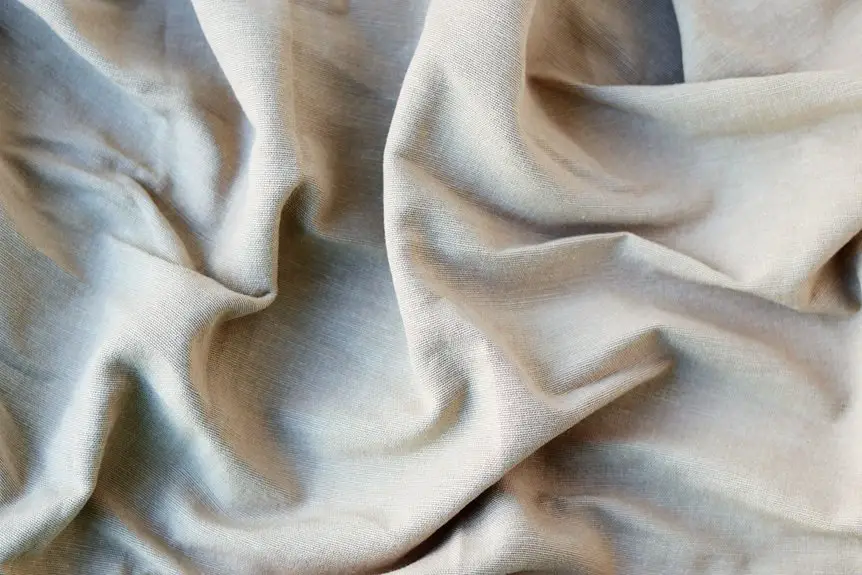To avoid wrinkles, try the Kari Method for storage by folding clothes flat and stacking them vertically. Rolling is perfect for travel; lay clothes flat, smooth them out, and roll tightly. For t-shirts, use the double-shoulder fold to keep them compact. Don’t forget accessories like dry cleaning bags and tissue paper to prevent creases. Finally, choose fabrics like polyester for wrinkle resistance. Stick around to explore more tips and tricks for wrinkle-free living!
Table of Contents
Key Takeaways
- Use the Kari Method by folding clothes flat to minimize creases and stack them vertically for easy access and visibility.
- Roll clothes tightly, especially for travel, to save space and prevent wrinkles during transit.
- Apply the double-shoulder fold technique for t-shirts to keep them compact and wrinkle-free.
- Utilize accessories like dry cleaning bags and tissue paper to create a buffer and protect garments from creasing.
- Choose wrinkle-resistant fabrics such as polyester or blends to reduce the need for ironing and maintain a fresh look.
Kari Method Adaptation for Storage
When it comes to storing clothes without wrinkles, the Kari Method offers a practical solution. This technique emphasizes folding clothes in a way that minimizes creases and maximizes space.
Start by laying your garment flat, smoothing out any wrinkles. Then, fold the sleeves inward towards the center, followed by folding the shirt in half lengthwise. For pants, fold them in half, then again, ensuring the fabric lies flat.
Once folded, stack your garments vertically in the storage space, allowing you to see everything at a glance. By using this method, you not only keep your clothes wrinkle-free but also make it easy to access what you need without rummaging through piles.
It’s a simple, effective way to maintain your wardrobe.
Rolling Techniques for Travel
After mastering the Kari Method for storage, you might want to contemplate rolling techniques for travel. Rolling your clothes can save space and help prevent wrinkles.
Start by laying your garment flat, smoothing out any creases. For shirts, fold the sleeves inward and then roll tightly from the bottom up. For pants, fold them in half lengthwise, then roll from the waistband down. You can also use this technique for dresses and skirts, starting at the hem.
Keep your rolled items organized in your suitcase by using packing cubes or placing them in a way that minimizes movement. This method not only maximizes space but also keeps your clothes in better shape during your travels.
Double-Shoulder Fold for T-Shirts
To keep your t-shirts wrinkle-free and neatly stored, the double-shoulder fold is an effective technique.
Start by laying your t-shirt face down on a flat surface. Smooth out any wrinkles, ensuring the fabric is even.
Next, fold the sleeves inward towards the center of the shirt, creating a straight line along the sides.
Then, fold the bottom of the shirt up to meet the neckline.
Finally, take the top portion of the shirt, where the shoulders are, and fold it down over the body of the shirt.
This method not only minimizes creases but also keeps your t-shirts compact and easy to stack.
You’ll appreciate how organized and wrinkle-free your closet looks with this simple fold!
Use of Accessories for Wrinkle Prevention
To keep your clothes wrinkle-free, consider using accessories like dry cleaning bags, tissue paper buffers, and packing folders.
These tools help protect your garments during storage and travel. By incorporating these simple items, you can maintain a polished look with minimal effort.
Dry Cleaning Bags
Dry cleaning bags aren’t just for transporting freshly cleaned clothes; they can also be your secret weapon against wrinkles. When you store your garments in these bags, you create a protective barrier that minimizes creasing.
Here’s how to make the most of them:
- Hang, Don’t Fold: Whenever possible, hang your clothes in the dry cleaning bag to maintain their shape.
- Seal the Bag: Close the bag tightly to keep dust and moisture away, which can contribute to wrinkles.
- Avoid Overstuffing: Don’t cram too many items into one bag. This extra pressure can lead to unwanted folds and creases.
Using dry cleaning bags wisely helps keep your clothes looking crisp and ready to wear.
Tissue Paper Buffer
A simple yet effective accessory for preventing wrinkles is tissue paper. When you fold your clothes, layering tissue paper between items can create a protective barrier. This cushioning helps to minimize friction and pressure, which are common causes of creases.
To use tissue paper, cut sheets to fit the size of your garments. Place a sheet inside and between each layer of clothing, especially for delicate fabrics. As you fold, make sure to keep the tissue paper smooth to avoid any bunching.
This method works particularly well with dresses, blouses, and trousers. By incorporating tissue paper into your packing routine, you’ll find your clothes arrive at your destination in much better condition, free from unsightly wrinkles.
Packing Folders Usage
Packing folders are a game changer when it comes to keeping your clothes wrinkle-free during travel. These handy accessories simplify your packing process and protect your garments.
Here’s how to make the most of them:
- Organize Efficiently: Use packing folders to categorize your clothes—group similar items together to maximize space and minimize wrinkles.
- Layer Smartly: Place heavier items at the bottom and lighter ones on top. This helps distribute weight evenly, reducing creasing.
- Secure Straps: Most packing folders come with built-in straps. Use these to hold your clothing in place, preventing movement that can lead to wrinkles.
Strategies for Choosing Wrinkle-Resistant Fabrics
When you’re selecting fabrics that resist wrinkling, consider materials like polyester, nylon, or blends that include spandex. These fabrics not only hold their shape but also maintain a polished look throughout the day. Additionally, look for fabrics treated with wrinkle-resistant finishes for added protection.
Here’s a quick comparison of common fabrics:
| Fabric Type | Wrinkle Resistance |
|---|---|
| Polyester | High |
| Cotton | Low |
| Nylon | Moderate |
| Spandex Blends | High |
Choosing the right fabric can greatly reduce your ironing time and keep your clothes looking fresh. Remember, the right combination of fibers will help you conquer wrinkles effortlessly!
Tips for Efficient Packing
To guarantee your clothes arrive wrinkle-free, you’ll want to master the art of efficient packing.
Here are three tips to help you along the way:
- Roll Your Clothes: Instead of folding, roll your garments tightly. This minimizes creasing and saves space in your suitcase.
- Use Packing Cubes: These handy organizers keep your items compartmentalized. They help prevent shifting during travel, reducing the chance of wrinkles.
- Layer Strategically: Place heavier items at the bottom and lighter ones on top. This way, you avoid crushing delicate fabrics under weight.
Frequently Asked Questions
How Can I Fold Clothes Without Any Tools?
You can fold clothes without any tools by laying them flat, smoothing out wrinkles with your hands, and neatly stacking or rolling them. This method’s simple and effective for keeping everything organized and tidy.
What Is the Best Way to Store Formal Shirts?
To store formal shirts, hang them in a breathable garment bag or on sturdy hangers. Make sure the closet’s cool and dry, and avoid overcrowding to keep them looking sharp and fresh.
Can I Use Vacuum Bags for Wrinkle Prevention?
Yes, you can use vacuum bags for wrinkle prevention. They compress clothing, minimizing movement and reducing creases. Just make certain you pack your garments neatly, and they’ll stay fresh and wrinkle-free until you’re ready to wear them.
How Do I Prevent Wrinkles in Delicate Fabrics?
Did you know that 70% of people damage delicate fabrics through improper care? To prevent wrinkles, always wash in cold water, use a gentle cycle, and hang or lay flat to air dry. You’ll maintain fabric integrity!
Is There a Specific Order to Fold Larger Items?
When you fold larger items, start by laying them flat, folding in the sides first. Next, fold from the bottom up, ensuring each crease is smooth. This method helps maintain shape and makes packing easier.
- Can Nonwoven Fabric Be Used for Upholstery? - July 11, 2025
- The Complete Guide to Nonwoven Polypropylene Tote Bags - July 11, 2025
- What Is Hydrophilic vs. Hydrophobic Nonwoven Fabric? - July 11, 2025







